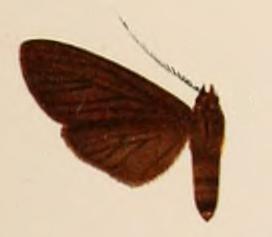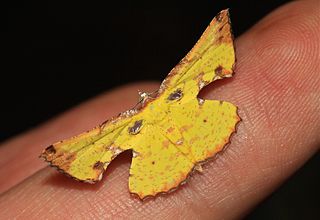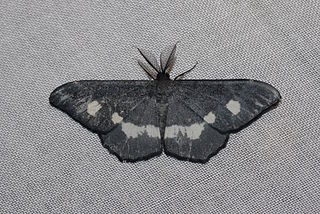
Micronia is a genus of moths of subfamily Microniinae of family Uraniidae. The genus was erected by Achille Guenée in 1857. The species of this genus are found in India, Sri Lanka, Indonesia and Papua New Guinea.

Pelochyta is a genus of moths in the family Erebidae. The species was first described by Jacob Hübner in 1819. They are distributed in Africa, throughout India, Myanmar, Sri Lanka, Australia and New Britain.

Arrade is a genus of moths of the family Erebidae described by Francis Walker in 1863.
Mesolia is a genus of moths of the family Crambidae described by Émile Louis Ragonot in 1889.

Corcobara is a monotypic moth genus of the family Erebidae first described by Frederic Moore in 1882. Its only species, Corcobara angulipennis, described by the same author in the same year, is found in India, Thailand, Cambodia, Myanmar, Malaysia, Indonesia, New Guinea, Sri Lanka and the Solomons.
Dierna is a genus of moths of the family Erebidae erected by Francis Walker in 1859.
Holocryptis is a genus of moths of the family Noctuidae erected by Thomas Pennington Lucas in 1893.
Nagadeba is a genus of moths of the family Noctuidae first described by Francis Walker in 1866.
Niaccaba is a monotypic moth genus of the family Noctuidae first described by Francis Walker in 1866. Its single species, Niaccaba sumptualis, described by the same author one year earlier, is found in Sri Lanka, the Ryukyu Islands and Borneo.

Perina is a genus of tussock moths in the family Erebidae. It was described by Francis Walker in 1855 and is found in China, Sri Lanka and throughout India.

Amblychia is a genus of moths in the family Geometridae described by Achille Guenée in 1857.

Aporandria is a monotypic moth genus in the family Geometridae described by Warren in 1894. Its single species, Aporandria specularia, was first described by Achille Guenée in 1857. It is found in Sri Lanka, India, Vietnam, Thailand, the Andamans, Peninsular Malaysia, Sumatra, Borneo, the Philippines and Sulawesi.

Corymica is a genus of moths in the family Geometridae described by Francis Walker in 1860.

Hyperythra is a genus of moths in the family Geometridae. It was erected by Achille Guenée in 1857.

Hyposidra is a genus of moths in the family Geometridae first described by Achille Guenée in 1857.

Timandra is a genus of moths in the family Geometridae first described by Philogène Auguste Joseph Duponchel in 1829.

Zeheba is a genus of moths in the family Geometridae described by Moore in 1887.

Cacyparis is a genus of moths in the family Nolidae erected by Francis Walker in 1863. It is found in throughout India, Sri Lanka, Myanmar, Papua New Guinea and Australia.

Rhodoneura is a genus of moths of the family Thyrididae described by Achille Guenée in 1858.
Callidrepana amaura is a moth in the family Drepanidae first described by Warren in 1901. It is found in Nigeria.













